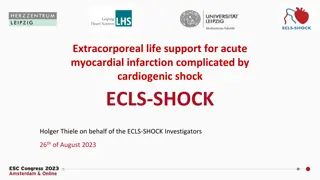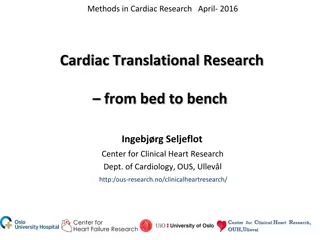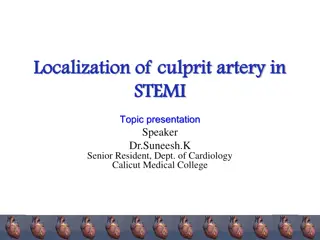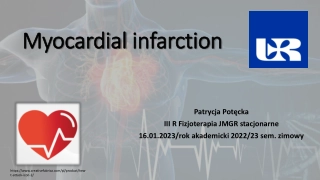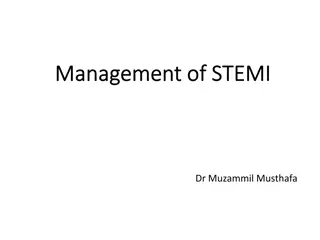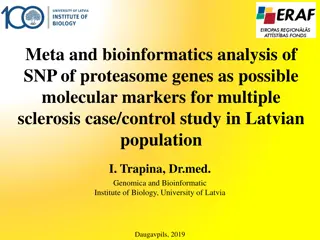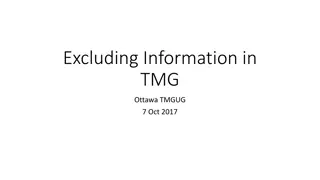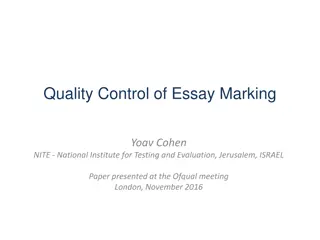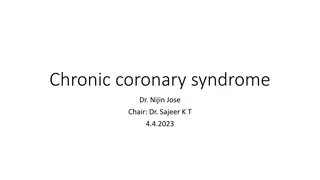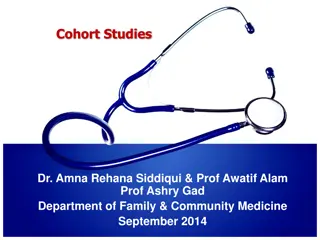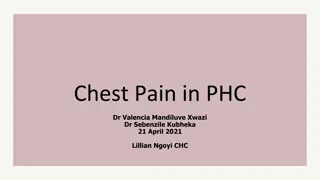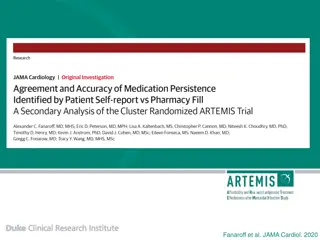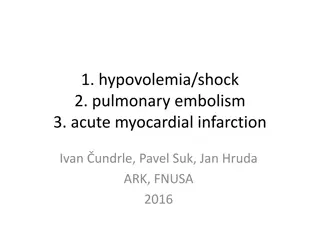Understanding Biochemical Markers of Myocardial Infarction
This lecture covers the criteria for diagnosing myocardial infarction (MI), features of ideal MI markers, the significance of plasma marker changes, and properties of markers such as cardiac troponins, creatine kinase, and myoglobin. It also discusses the new markers used for diagnosing MI and provides a case study for better understanding. By the end, students should have a comprehensive knowledge of MI markers and their diagnostic value.
Download Presentation

Please find below an Image/Link to download the presentation.
The content on the website is provided AS IS for your information and personal use only. It may not be sold, licensed, or shared on other websites without obtaining consent from the author. Download presentation by click this link. If you encounter any issues during the download, it is possible that the publisher has removed the file from their server.
E N D
Presentation Transcript
Biochemical Markers of Myocardial Infarction Cardiovascular Block Dr. Usman Ghani
Objectives By the end of this lecture, the students should be able to: Recall the criteria for diagnosis of myocardial infarction (MI) Know about the features of an ideal MI marker Understand the significance of plasma marker changes over time Identify properties and diagnostic value of MI markers such as cardiac troponins, creatine kinase and myoglobin Be familiar with some of the new markers
Overview Myocardial infarction (MI) Criteria for diagnosis of MI Features of an ideal MI marker Time-course of plasma enzyme changes Cardiac troponins I and T Creatine kinase (CK-MB) Myoglobin Heart fatty acid binding protein (h-FABP)
Myocardial infarction (MI) Occlusion of coronary arteries Restricted blood supply (oxygen) to heart tissue (ischemia) Damage to heart tissue (infarction) Release of enzymes and other proteins into the blood (markers)
Criteria for diagnosis of MI Recommended by the European Society of Cardiology and American College of Cardiology Requires presence of at least two of the following characteristics: 1. Typical heart attack symptoms 2. Characteristic rise and fall pattern of a cardiac marker in plasma Rise and gradual fall of cardiac troponins More rapid rise and fall of CK-MB 3. Typical ECG pattern Reference: Alpert JS, Thygesen K, Antman E, Bassand JP. J Am Coll Cardiol. 2000, 36(3):959.
CASE A 66-year-old man had experienced central chest pain on exertion for some months, but in the afternoon of the day prior to admission he had had a particularly severe episode of the pain, which came on without any exertion and lasted for about an hour. On admission there were no abnormalities on examination and the ECG was normal. The troponin was clearly detectable. Comment on these results. Has he suffered a myocardial infarction? Comments: He has elevated troponin plus a typical history. This is sufficient to diagnose a myocardial infarction by the most recent definition, even in the absence of ECG changes.
CASE, CONTINUED A 66-year-old man had experienced central chest pain on exertion for some months, but in the afternoon of the day prior to admission he had had a particularly severe episode of the pain, which came on without any exertion and lasted for about an hour. On admission there were no abnormalities on examination and the ECG was normal. The troponin was clearly detectable. Comment on these results. Has he suffered a myocardial infarction? Comments: He has an elevated troponin plus a typical history. This is sufficient to diagnose a myocardial infarction by the most recent definition, even in the absence of ECG changes. 1- Typical heart attack symptoms 2- Characteristic pattern of a cardiac marker
Features of an ideal cardiac marker High concentration in the myocardium High sensitivity (detected even in low concentration at early stages of the disease) High specificity (specifically detecting damage of cardiac tissue, and is absent in non-myocardial tissue injury)
Features of an ideal cardiac marker Rapid release into plasma following myocardial injury Good prognostic value (strong correlation between plasma level and extent of myocardial injury) Easily measured (detectable by rapid, simple and automated assay methods)
Plasma MI markers CURRENT MARKERS Troponin T Troponin I Creatine kinase-MB (CK-MB) Myoglobin MARKERS WITH POTENTIAL CLINICAL USE Heart fatty acid binding protein (hFABP) (tissue ischemia) OBSOLETE MARKERS Aspartate Transaminase (AST) Lactate dehydrogenase (LDH)
Markers of diagnostic value in MI: Cardiac troponins T and I Creatine kinase (CK-MB) Myoglobin Markers of diagnostic value in tissue ischemia: Heart fatty acid binding protein (hFABP)
Time-course of plasma enzyme changes Plasma enzymes follow a pattern of activities after MI The initial lag phase lasts for about 3 hours Enzymes rise rapidly to peak levels in 18-36 hours The levels return to normal based on enzyme half-life Rapid rise and fall indicates diagnostic value
Blood samples collected after MI: Baseline (upon admission) Between 12 and 24 hours after the onset of symptoms
Marker changes in blood Enzyme / Protein Detectable (hours) Peak value (hours) Duration (days) Cardiac troponins 3-4 ~48 Up to 10 CK-MB 3-10 12-24 2-3 Myoglobin 1-4 6-9 1
Troponins Troponins are structural proteins in cardiac myocytes and in skeletal muscle Cardiac troponins (cTn) are structurally different from muscle troponins Involved in the interaction between actin and myosin for muscle contraction
Troponins cTn are mainly bound to proteins, with small amount soluble in the cytosol Highly specific markers for detecting MI Two main cardiac troponins (cTn): cTnI: inhibitory protein cTnT: binds to tropomyosin
Troponins Appear in plasma in 3- 4 h after MI Remain elevated for up to 10 days After a MI, cytosolic troponins are released rapidly into the blood (first few hours) Structurally bound troponins are released later for several days
Creatine kinase (CK) Three main CK isoenzymes with two polypeptide chains B or M Type Composition Comment Skeletal Muscle 98% CK-MM 2% CK-MB Elevated in muscle disease Cardiac muscle 70-80% CK-MM 20-30% CK-MB Cardiac muscle has highest amount of CK- MB Brain CK-BB Plasma Mainly CK-MM
CK-MB CK-MB is more sensitive and specific for MI than total CK It rises and falls transiently after MI Appears in blood within 3-10 h. of heart attack Peaks in blood in 12 24 h. Returns to normal within 2-3 days Relative index = CK-MB mass / Total CK x 100 More than 5 % is indicative for MI
CK-MB Advantages: Useful for early diagnosis of MI Useful for diagnosis of re-infarction Disadvantages: Not significant if measured after 2 days of MI (delayed admission) Not highly specific (elevated in skeletal muscle damage)
CASE A well-trained marathon runner collapsed as he was approaching the finishing line. His ECG was normal, but CK was elevated at 9500 U/L (reference range 30 200 U/L), and the CK-MB was 14% of the total CK (normally <6%). Troponin was undetectable. Comment on these results. Comments: The total CK is substantially elevated, and CK-MB >6% can usually be taken to mean that it is of myocardial origin. However, the normal ECG and troponin are both reassuring. In trained endurance athletes, the proportion of CK-MB in muscle increases from the normal low levels and may be as high as 10 15%. An elevated CK-MB in such individuals can no longer be taken to imply a cardiac origin for the raised CK. Extreme exercise, especially in unfit individuals, causes an elevated CK, potentially to very high levels.
CASE A well-trained marathon runner collapsed as he was approaching the finishing line. An ECG was normal, but CK was elevated at 9500 U/L (reference range 30 200 U/L), and the CK-MB was 14% of the total CK (normally <6%). Troponin was undetectable. Comment on these results. Comments: The total CK is substantially elevated, and CK-MB >6% can usually be taken to mean that it is of myocardial origin. However, the normal ECG and troponin are both reassuring. In trained endurance athletes, the proportion of CK-MB in muscle increases from the normal low levels and may be as high as 10 15%. An elevated CK-MB in such individuals can no longer be taken to imply a cardiac origin for the raised CK. Extreme exercise, especially in unfit individuals, causes an elevated CK, potentially to very high levels.
Myoglobin Myoglobin is a sensitive marker of cardiac damage Appears in blood early (within 1-4 hours) Rises very rapidly after the MI at about the same rate as CK-MB It is non-specific because it is elevated in: Muscle disease/injury Acute and chronic renal failure
Heart fatty acid binding protein (h- FABP) A cytosolic protein involved in fatty acid transport and metabolism A promising marker to be used in combination with troponins Higher amounts in myocardium than in brain, kidney and skeletal muscle Appears in blood as early as 30 min. after acute ischemia Peaks in blood in 6-8 h. Returns to normal levels in 24-30 h.
B-type natriuretic peptide (BNP) (heart failure marker) A peptide produced by the ventricles of the heart in response to: Myocardial stretching and ventricular dysfunction after MI Causes vasodilation, sodium and water excretion and reduces blood pressure A marker for detecting congestive heart failure Its serum levels are high in some pulmonary diseases But in heart failure its levels are markedly high An important marker for differential diagnosis of pulmonary diseases and congestive heart failure
BNP BNP cTn CK-MB Myoglobin h-FABP Pathogenesis of MI with special focus on the biomarkers implicated in the development of MI.
Take home message cTn Currently the most definitive markers and are replacing CK-MB Highly specific to heart muscle damage They remain elevated in plasma longer than CK-MB They have higher sensitivity and specificity than CK-MB CK-MB Its main advantage is for detecting re-infarction Myoglobin An early marker of MI h-FABP An early marker for detecting acute ischemia prior to necrosis
References Lecture Notes on Clinical Biochemistry 9th Edition A.F. Smith, Blackwell Publishing, UK. Sharma, N. and Ahmad, M.I. Biomarkers in acute myocardial infarction. J. Clin. Exp. Cardiol. 2012, 3: 11-18.


